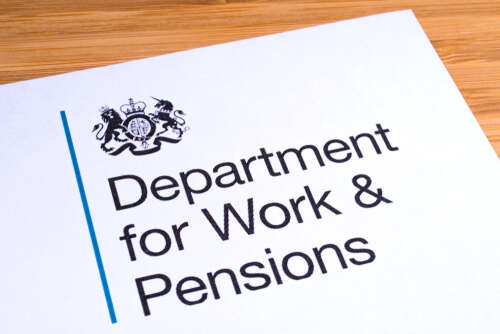
The civil servant workforce at the Department of Work and Pensions (DWP) could be working from home more often after it was confirmed that it will spend just under £700m over 10 years on a workplace transformation programme aimed at modernising how the department operates and cutting its carbon footprint.

Joining departments such as HMRC and Disclosure and Barring Service (DBS), DWP is making a move towards a more flexible way of working. The government department told Tech Monitor that the way DWP works and delivers services is changing, and that the programme would not be “estate-driven”, meaning there will be less focus on work being carried out in the department’s physical offices. “It will reshape how, when and where employees for DWP work,” a spokesperson said, adding that it would enable service “modernisation” for the end-users across the UK.
DWP is responsible for welfare, pensions and child maintenance policy and is the biggest public service department. It is responsible for administering the state pension and a range of working-age, disability and ill-health benefits to around 20 million claimants. It is also the fourth largest producer of greenhouse gases at Whitehall due to the size of its property estate. And when it comes to digital transformation, this size could prove a barrier to change, with many of the divisions of the department used to working in siloes.
What is DWP’s workplace transformation programme?
Formally starting in 2021, the transformation plan is a 10-year programme that will make DWP “smarter, better and greener” in line with the Government’s ambitions around public estates. In his Accounting Officer Assessment for the programme, Peter Schofield, permanent secretary, DWP, said that the plan will support the “ongoing service modernisation and transformation of work while driving for efficiency with the implementation of a flexible workplace.”
“Organisational, cultural, digital and estate changes will alter how the Department’s people interact with their workplace,” he wrote. “The implementation of more flexible ways of working, as Smarter Working is embedded will improve the lives of the Department’s people.”
As it stands, many of DWP’s buildings do not meet modern building standards and more than 60% are over 30 years old. It occupies 20% of the Government’s civil estate, being the fourth largest producer of greenhouse gases within the government. A spokesperson confirmed to Tech Monitor that a formal evaluation is in progress and early anecdotal feedback has been positive, though they did not confirm from whom.
“The estate design, footprint and location will result in fewer, better-quality buildings, supporting Places for Growth and the Levelling Up agenda,” writes Schofield. “Investment in the condition and future sustainability of the estate will support the Greening Government commitments and Net Zero Carbon Targets.”
The transformation has been given the green light by the Treasury through the government’s Major Projects Portfolio, which is used to fund complex or expensive infrastructure schemes. An investment of £693m will be made into the project, and it is expected that £3.5bn will be saved over 30 years, with £80–90m being realised from 2028/2029, says DWP.
“By 2025, we will be leaner; but more agile and better-equipped to serve our customers and respond to the future,” says DWP. “We are on track to deliver the ambitious plan for this Spending Review, but we are already starting to look ahead to how we can go further.”
Government departments moving towards flexible working
Since the start of the Covid-19 pandemic, civil servants have slowly, but surely, moved to a hybrid way of working.
At the beginning of the pandemic, DWP was one of only two departments that saw double-digit numbers of workers work from home. But this changed and by December 2020, DWP Digital wrote about how it was enabling more civil servants to work from home.
Other departments are also making significant progress, and the DBS chief executive recently talked about how hybrid working had contributed to better productivity. Speaking to Civil Service World, Eric Robinson said that remote and hybrid working had made a “significant positive effect” on the department’s performance.
In 2021/2022, DBS issued 7.1 million DBS certificates, which was up from 5.96 million in 2019/2020. It surpassed the government’s target of issuing 80% of enhanced DBS certificates within 14 days and received a customer satisfaction index score of 81.4% in 2021 – the highest-rated public sector organisation for customer satisfaction. Offering staff more flexibility meant that services improved, something that Robinson didn’t expect.
Rob Anderson, research director for the public sector at GlobalData, says the Covid-19 lockdowns acted as a catalyst for starting remote-working programmes across government. “It was clearly brought about partly because of Covid-19 with a lot of their people working remotely,” he says. “So it made sense to review the situation.”
The way government departments now work from home has started a chain reaction when it comes to government estate. MP Jacob Rees-Mogg, minister for Brexit opportunities and government efficiencies, confirmed he was planning to sell off £1.5bn worth of government offices in London due to the proportion of civil servants continuing to work from home.
Implementing modernisation is going to be slow
DWP is supported by 13 agencies and public bodies. As of December 2022, DWP employed and contracted a total of 86,523 people – 77,398 worked full-time. As the biggest government department, it’s clear there will be challenges and sacrifices along the way in achieving transformation.
When asked by Tech Monitor about how DWP would implement digital into its workplace transformation, the department declined to comment. Anderson believes that this is because, like many government agencies, DWP works in a siloed environment.
“People working on [other things] won’t necessarily be talking to the people on the digital side of it,” Anderson says. “[DWP Digital] should be talking to uts users about what this means. However, things get lost in translation. Just transforming the current state [of DWP] isn’t going to address the future needs.”
Anderson says that DWP Digital need to be embedding the workforce transformation programme into its roadmaps to ensure the new working environments work for all users.






